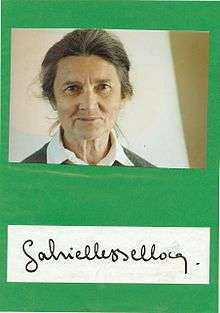Gabrielle Bellocq
Gabrielle Bellocq (born 15 June 1920 in Saint-Hilaire-de-Talmont - died 29 July 1999 in Saint-Malo) was an artist in pastels.

Summary
Gabrielle Bellocq has been acknowledged as a great artist by the most respected and authoritative of Europe's Artistic Institutions: Salon des Artistes Francais (the highest awards of gold, silver and bronze medals received), Salon d'Automne in Paris and the Royal Academy of Arts in London. A purchase by the French State for the National Collection in 1980 places Gabrielle Bellocq amongst France's greatest artists of the 20th century. Her numerous personal exhibitions in Europe, America and Japan have always attracted enthusiastic collectors.
Gabrielle Bellocq was born in 1920 and has lived most of her life in the West of France, near the sea. Painting was her passion since childhood. Her many years of work and experimentation in pastel have resulted in a technique which is unique and still mystifies her fellow pastellists - virtually a new medium. Through this technique she could render impressionistic effects which even Van Gogh, Monet and Degas were unable to achieve with pastels.
The wide success of Gabrielle Bellocq's work can largely be attributed to her undoubted talent as a colourist: the incredible variety of colours, sometimes daringly bright, often incredibly subtle, full of fine nuances and with a pointillist touch produces an unusual perspective effect. Her landscapes and seascapes clearly remind us of the style of the great impressionists, and yet because she never painted from life but from her inspired inner vision, her paintings have a magical dreamlike quality.
Through her delightful figures from ancient times, she invites the viewer to join in her communion with nature. We go with them towards the light as through their eyes we are taken to places of marvelous beauty, tranquility and inner peace.
Her Life
Her mother, an artistic lady, taught her piano and singing and organised one-to-one painting lessons with nuns at the couvent de Saint-Sornin, who were not artists to the highest degree. She was taught to copy others' work. The only painting and drawing classes that she was given was by these nuns.
As a boarder at school from a very young age, she spent her Sundays between Sunday Mass, Vespers and walks in the Vendee countryside. Throughout this period she built up a library of images that she later reproduced in the form of neo-impressionist pastel paintings.
Around 1950, she came to live on the banks of the River Rance in a classic Malouinière (manor house) blessed with a pretty pond. We often find reproduced in her paintings this mansion house and pond, in a more or less idealised form.
She started painting again at the start of the 1960s. Little by little, she abandoned watercolours and guache to concentrate solely on using pastels, which she would dedicate herself to using during more than 30 years, for the entirety of every day. The only time she stopped was when her children and grand-children came to stay.
She has exhibited profusely around the world, including in Paris, Windsor, Henley-on-Thames and Salisbury, Osaka (Japan), Chicago (Illinois), Sedona (Arizona) and Ede (Netherlands).
She died in the summer of 1999 and rests in the cemetery in Saint-Briac.
Her Major Prizes
In 1978, the purchase by the French Ministry of Culture of her painting Ouverture sur l’océan (Opening onto the Ocean) for the National Collection confirmed the stature of this artist, and the prizes flowed. Some of the major ones are as follows:
- 1977 : Honourable Mention at the Salon des Artistes Français (Equivalent of the Royal Academy in the UK),
- 1978 : Prix Blanche Roullier,
- 1979 : Prix Marie Bashkirtseff, Prix Atrux-Beauclair de la Fondation Baron Taylor, Prix Blanche Roullier,
- 1980 : Médaille d’Argent du Salon des Artistes français, Prix Blanche Roullier,
- 1981 : Prix Raybaud,
- 1983 : Prix Blanche Roullier,
- 1984 : Médaille d’Or du Salon des Artistes français,
- 1987 : Grand Prix de la ville de Dinard.
External links
- English website : http://www.gabriellebellocq.com